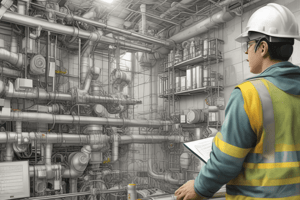Podcast
Questions and Answers
Which of the following fields are included in occupational safety and health?
Which of the following fields are included in occupational safety and health?
- Occupational Safety
- Occupational Health
- Industrial Hygiene
- All of the above (correct)
What is a hazard?
What is a hazard?
A source or situation with a potential to cause harm.
What are the two major causes of accidents in the workplace?
What are the two major causes of accidents in the workplace?
Hazardous Act/Human Factor and Hazardous Condition.
What are the types of accidents mentioned?
What are the types of accidents mentioned?
The three steps to prevent accidents are to identify the hazards, evaluate the hazards, and ______.
The three steps to prevent accidents are to identify the hazards, evaluate the hazards, and ______.
What is trench excavation?
What is trench excavation?
A ladder must be located at least 30 ft away from a worker's working position.
A ladder must be located at least 30 ft away from a worker's working position.
What is shoring designed to do?
What is shoring designed to do?
Excavation over 6.6 m requires a protection system designed by a structural engineer.
Excavation over 6.6 m requires a protection system designed by a structural engineer.
What is heavy equipment defined as?
What is heavy equipment defined as?
Study Notes
Occupational Safety and Health
- Occupational safety and health involves three major fields: occupational safety, occupational health, and industrial hygiene.
- Occupational safety focuses on preventing accidents at work by understanding their causes and mitigating unsafe acts and conditions.
- Occupational health emphasizes the impact of hazards and risks on worker health, highlighting the importance of health programs to combat work-related illnesses.
- Industrial hygiene aims to identify, evaluate, and control physical, chemical, biological, and ergonomic hazards in the workplace.
- A hazard signifies a potential source of harm, leading to injury, illness, property damage, environmental harm, or a combination of these.
- Risk involves the likelihood of a hazardous event occurring and the severity of its consequences, encompassing harm to individuals, property, the environment, or a combination of these.
- Accidents are often the result of exceeding the body's or structure's threshold limit when exposed to a source of energy.
- The two major causes of accidents are hazardous acts/human factors and hazardous conditions.
- Common types of accidents include falls, falling debris, electrocutions, explosions/burns, slip and falls, trench/ground collapse, and overexertion.
- Preventing accidents and work-related illnesses involves three steps: identifying hazards, evaluating hazards, and correcting or controlling hazards.
Excavation Safety
- Excavations are crucial in construction and mining, encompassing tasks like building foundations, trenching, and tunneling.
- A trench excavation is narrow and deeper than its width, with a bottom width not exceeding 15 feet.
- Hazards in excavations arise from contact with underground utilities, falls of equipment and personnel, being struck by excavating equipment, and hazardous atmospheres.
- Types of soil collapse include general zone of exposure, rotation, spoil pile slide, side wall shear, and slough-in/cave-in.
- OSH requirements for excavation works include:
- Identifying underground utilities
- Training workers
- Ensuring personal protective equipment use
- Managing harmful dust, gases, and fumes
- Having experienced supervisors
- Conducting site inspections
- Implementing public protection and traffic control
- Providing access and egress
- Using barricades
- Implementing shoring and timbering
- Installing protection systems
Excavation Safety Requirements
- Excavations deeper than 2 meters require inspection.
- A ladder must be positioned within 25 feet (8 meters) of a worker's working position.
- Excavations exceeding 1 meter (3 feet) in depth must have access and escape routes for flooding or collapse situations.
- The tops of excavation walls exceeding 2 meters (6 feet) require barricades at least 1 meter (3 feet) high to prevent falls.
- Tools and materials should be kept at least 1 meter (3 feet) from the edge of the excavation.
- Excavation walls exceeding 1 meter (3 feet) in depth must be supported by adequate shoring and timbering to prevent collapse.
- Excavations exceeding 6.6 meters (21 feet) in depth necessitate protection systems designed by structural engineers and approved by authorities to prevent adjacent structure movement and collapse.
- Workers should not enter excavations deeper than 4 feet unless the sides are sloped to a safe angle.
- No slope can be steeper than 3 feet horizontal to 4 feet vertical.
Excavation Safety Terminology
- Shoring refers to a support system designed to prevent excavation side collapses.
- Sheet piling involves using interlocking steel sheets driven into the ground to create a continuous barrier.
- Shielding protects workers by utilizing trench boxes or other supports to prevent soil cave-ins.
Heavy Equipment
- Heavy equipment encompasses machines powered by engines or electric motors, typically exceeding 1,000 kilograms in weight and 10 horsepower in rating.
- Dump trucks haul excavated dirt and rocks.
- Bulldozers are used for pushing and moving earth, rocks, and debris.
- Excavators are used for digging, lifting, and loading materials.
Studying That Suits You
Use AI to generate personalized quizzes and flashcards to suit your learning preferences.
Related Documents
Description
This quiz covers key aspects of occupational safety and health, including the importance of identifying hazards and assessing risks in the workplace. Participants will learn about the roles of occupational safety, health programs, and industrial hygiene in preventing work-related accidents and illnesses. Test your knowledge of this essential field!




